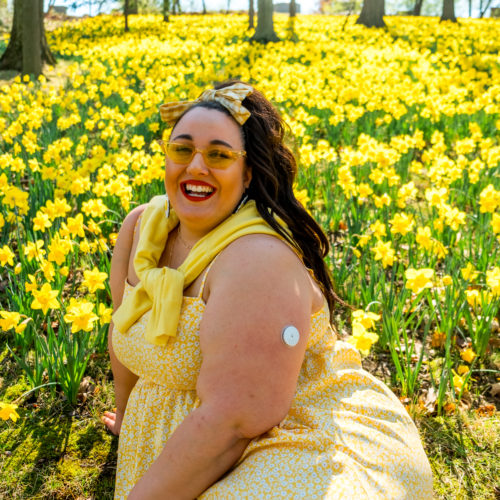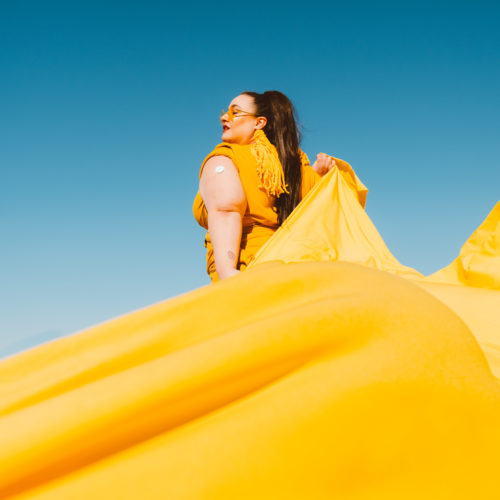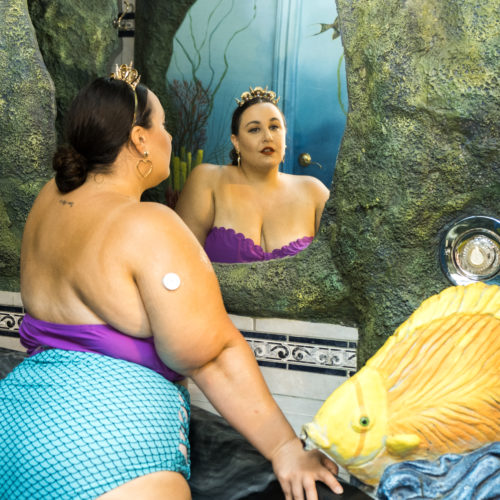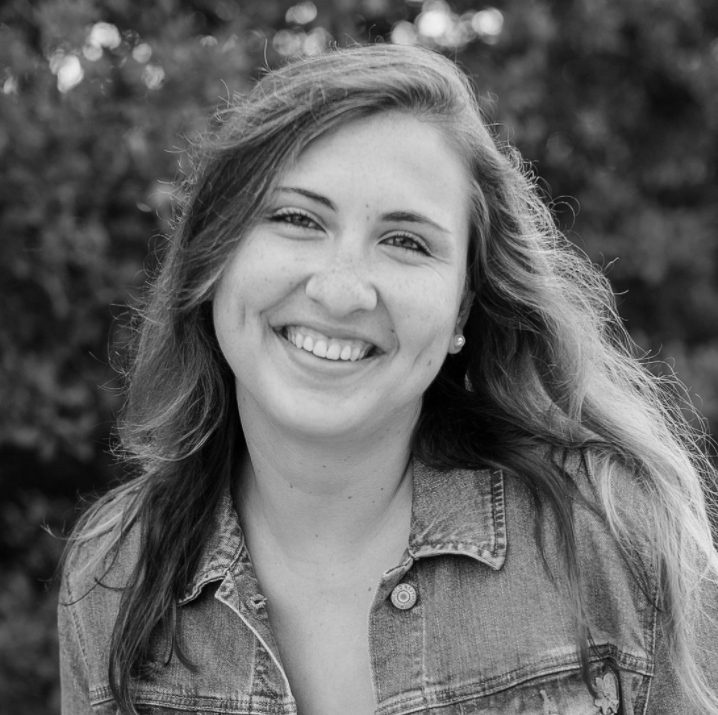Finding Adventure in Life with Type 2 + FreeStyle Libre
This interview was edited and condensed for clarity. All photos were taken by L.A. Carr of Manifest Media Haus. Alysse Dalessandro is an Abbott spokesperson and this content was created as part of a partnership between Beyond Type 1 and Abbott Diabetes Care Inc.
For Alysse Dalessandro, multi-tasking is a way of life. As a digital content creator, she’s familiar with long hours, a variety of tasks, hard work and some of the cool perks that come with the gig. Just before she set out on a cruise in 2016, she was diagnosed with type 2 diabetes (T2D). Luckily, with the help of her healthcare team, she was able to go on the cruise—she never lets diabetes stop her from adventure. This still holds true today.
As she’s shooting pictures and writing captions for her social media following, she’s also checking her blood sugar using the Freestyle Libre 2. Alysse spoke with us to discuss her journey with type 2 diabetes, how it’s impacted her career, and how the Freestyle Libre 2 has become her diabetes “push notification.”
BT2: Hi Alysse, thanks for chatting with us! When were you diagnosed with type 2 diabetes? What were some of the symptoms you had?
Alysse: Thanks for featuring my story and shining a positive light on those of us living with type 2 diabetes! I was diagnosed with type 2 in 2016. I really didn’t have any noticeable symptoms and I was diagnosed almost by accident. I was about to go on my first cruise and I wanted to get a prescription for motion sickness patches. To save money on that visit, I booked a full physical where they tested my A1C. I left with my prescription for motion sickness patches and didn’t think twice about my visit. The next day, I got a frantic call from my doctor saying I needed to come back in. I told him, “I’m headed on a cruise tomorrow, can this wait until I get back?” He said, “This cannot wait.” When I went into the office, my doctor broke the news that my A1C was 10.8 and that I had diabetes. We did some additional testing to see if it was type 1 or 2 and once we determined it was type 2, my doctor allowed me to go on the cruise with very strict instructions. I think the fact that I went on a cruise the day after getting diagnosed is very telling of how living with diabetes would go for me. I never let diabetes hold me back from adventure.
How does diabetes impact your day-to-day work as a digital content creator? What changes did you make to your everyday life after you were diagnosed?
Diabetes is a part of my life but it’s not my whole life. As a digital content creator, I don’t have set work hours. Some days I am shooting content for 14 hours and sometimes, it’s part of my job to sit on a beach or go ziplining. I have found that managing my diabetes means making sure that I have the tools I need. Wearing the FreeStyle Libre 2 (FSL 2) has absolutely changed the game for me. The alarms come as a notification on my phone so even when work may have me tuning out, my FSL 2 is right there to remind me—hey, your glucose levels are high.

How was the transition?
I was 26 years old when I was diagnosed, and I had been working as a content creator for four years. I had a social media platform when I was diagnosed. I made the conscious decision that I was going to spend the first year documenting the process I went through of understanding my diagnosis. There wasn’t a lot of information about weight neutrality and Health at Every Size as it is related to diabetes. I knew that if I talked publicly about diabetes as someone who was also known to be a body-positive advocate, I had to be informed. I spent that first year taking in as much as I could. One year after my diagnosis, I published my blog post, “I have diabetes and I still love my fat body.” This quickly became one of my most popular posts. It resonated with a lot of people who were also living with type 2 diabetes but had never heard anyone else share this perspective. Sharing my diagnosis with an informed Health at Every Size perspective really helped to challenge the stigma against type 2. I also found freedom by sharing my story and I’m happy that hearing my story helped others.
Did you start using insulin from the beginning or did you try other forms of treatment?
At this point, I have not been on insulin. I was put on metformin as soon as I was diagnosed. Having to start metformin while on a cruise was an experience because anyone who has been put on metformin knows how much it can mess with your stomach. Upon coming back, I asked to be put on metformin extended-release and I have been on that ever since. I tried a few other medications over the next few years and I have found that Januvia has the least number of side effects for me. Everyone’s bodies are different so listen to your body, talk to your doctor and find what works best for you.
How did you get started with the Freestyle Libre?
I first saw the FreeStyle Libre on a television commercial. I had always struggled with consistently checking my blood sugar. I was writing them down on a piece of paper and I always wished there was a way to track my blood sugar on an app. When I found that the FreeStyle Libre not only worked on your phone but didn’t require finger sticks, I knew I needed it. At first, my insurance wouldn’t cover it. I asked every three months for my doctor to check if it had been added to my plan and in early 2020, I started using it!

How did the Freestyle Libre help you improve your diabetes self-care?
As someone recovering from an eating disorder, it is very easy for me to “check out” from my body. My eating disorder thrived in disassociation. I found myself sometimes checking out and not checking my blood sugar regularly to make informed decisions. The FreeStyle Libre really helped me to stay connected to what was going on in my body and then make more informed decisions about what I would eat or do.
What were some changes that you noticed once you started using FSL?
The immediate change was that I started taking blood glucose readings up to five times a day. With fingersticks, there were days that I wouldn’t even check. The FSL was so easy to use. I just had to scan my phone. Over the course of using the FSL, I did see my A1C drop three points. Of course, some days are better than others but overall, I feel more in tune with my diabetes when I am wearing the FSL!
Do you think more people with type 2 diabetes should have access to devices like FSL?
I absolutely think that everyone living with diabetes should have access to a CGM (continuous glucose monitor). I was actually on Medicaid when I got diagnosed with diabetes as I was transitioning my business from designing to blogging. I remember having limited options for the diabetes supplies that I could access. At that time, no one told me about CGMs. There was one type of test strip that I could use, one type of needle and one monitor. I think about how much better my diabetes management would have been if I had the FSL from the beginning. I believe that everyone, regardless of their income, should be able to access the tools that can help them live their fullest lives with diabetes. I know that the team at FreeStyle Libre feels the same and that they are involved in advocacy work to get FSLs into the hands of those who need it most.

What are your favorite features of the FSL?
At first, my favorite feature of the Freestyle Libre was the alarms. It immediately helped remind me to really check-in when I had disconnected from my body. It was like a push notification to check my levels—like a text from a friend, these notifications are the nudge I need! I still love the alarms but I have also learned to appreciate the graphs. During my doctor’s appointments, we look at these graphs together to discuss treatment options. I reference them at home as well to make adjustments to when or what I am eating. I can use the graphs to see when I am more likely to go high or low and adjust accordingly.
What are your thoughts on ‘time in range’ as a metric compared to A1C?
I think that both time in range and A1C are valuable metrics. Even though I have plenty of “time in range” data for periods of time on my FSL, I still get an A1C reading every three months at my doctor’s office. Before having my FSL, I scheduled all of these appointments for accountability. A lot of larger-bodied folks have trauma from years of fatphobia in the medical industry and I am no stranger to that. When I was diagnosed with diabetes, I couldn’t avoid the doctor anymore. Instead, I scheduled these check-ups every three months and worked with my doctor to be weight neutral. Together, we use my A1C as the metric of how well I am able to manage my diabetes. My A1C has been across the board (shoutout to the stress of planning a wedding) but my weight has stayed the same. This further proves to me what I already knew—your weight is not a reflection of your health and it’s not a reflection of how well you are managing your diabetes.
What are some words of inspiration to other people with T2D?
You can live a full life with diabetes. This diagnosis is not a death sentence. Yes, diabetes will change your life but it will only limit you if you allow it to. Make adjustments that make sense for you and your body. Recognize that everyone’s bodies are their own. Learn to put up boundaries to protect yourself from unsolicited opinions—you’ll get a lot of them. I love to ask those people if they are my doctor. That usually shuts it down pretty quickly!
Diabetes distress is common in the T2D community, especially because of the stigma that comes with the disease. What is one self-care act you like to do?
The stigma against the type 2 community is so deeply ingrained in our society. When I was first coming up as a plus model and digital content creator, I remember online trolls would try to threaten me saying I was going to get diabetes. They hurled this at me like a death sentence and a condemnation. Now that I am living with diabetes, I realize even more now that those comments are made out of fear and are a projection of their own insecurities. A self-care act that I have practiced is being liberal when ‘blocking’ people online. This helps protect my own mental state but also keeps my online community safe.
YOU ARE NOT ALONE. JOIN THE BT2 COMMUNITY!
A place for everyone impacted by type 2 diabetes to share their stories, get connected to one another and find resources on topics from daily management to mental health. Now with the support of our friends at the American Diabetes Association, get instantly connected to other people who just get it—ask questions, share successes, vent about it in a safe and respectful platform designed specifically for people impacted by T2D. Here you’ll find a collection of practical ideas, stories and resources in both English and Spanish, for not only living with type 2, but thriving with it.
Were you recently diagnosed? Learn how to find the mental health support that you need here and how to find a mental health provider here.
Want to share your story with us? Share your story or submit clinical content here.





